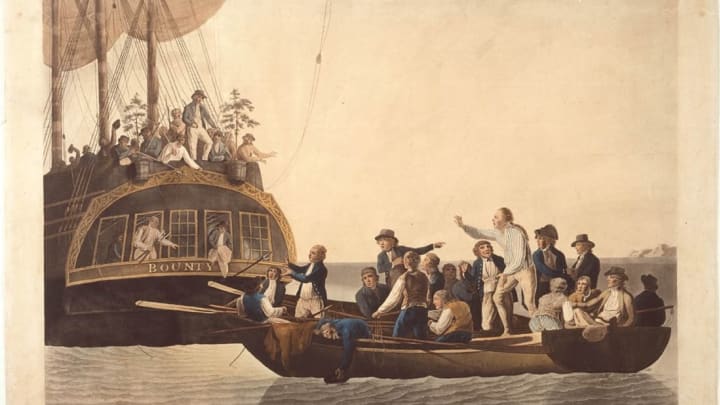On April 28, 1789, Fletcher Christian and 18 other sailors aboard the HMS Bounty wrested control of the ship from their commanding officer, Lieutenant William Bligh. The mutineers sent Bligh and the members of the crew loyal to him off in a lifeboat in the South Pacific, then set sail to some nearby islands for new lives in a tropical paradise. More than 230 years later, their actions may help researchers unlock the mysteries of the migraine.
A 1222-Hour Tour
Without charts or a compass, and relying only on a quadrant and his pocket watch, Bligh navigated the lifeboat on a 47-day, 3618-nautical-mile voyage and safely landed at Timor in the Dutch East Indies. From there he returned to England, two years after he left, and reported the mutiny. He eventually achieved the rank of Vice Admiral of the Royal Navy.
Meanwhile, the mutineers didn’t fare as well. They first attempted to settle on the island of Tubai, but abandoned it after three months of near constant harassment and attack by the natives. Some of the men settled in Tahiti, and the rest moved on to Pitcairn Island, where they burned the ship in what is now called Bounty Bay. As the mutineers settled into island life, the Crown dispatched the HMS Pandora to retrieve the men and bring them home for trial. The Pandora arrived at Tahiti in early 1791 and 14 of the mutineers were arrested within a few weeks. The ship collided with a part of the Great Barrier Reef during its return trip, losing 31 crew and four of the prisoners, but the remaining 10 mutineers eventually made it back to England, where they were tried in a naval court.
The mutineers on Pitcairn managed to avoid detection. Some of them married natives or Tahitians who had hopped aboard the boat when it stopped there. They started families. By 1855, they numbered around 200, and the 88 acres of usable land on the island could no longer sustain the population. Queen Victoria provided some relief and granted the mutineers' descendants Norfolk Island, a former penal colony a few thousand miles west. The next year, they abandoned Pitcairn and settled their new home. Some eventually went back to Pitcairn, and today about 50 people live there. All but a handful are direct descendants of the mutineers. The rest stayed at Norfolk, and today’s inhabitants include approximately 1000 Bounty descendants, about half the island’s population.
No Day at the Beach
Life on Pitcairn and Norfolk can be tough. The only real way to reach Pitcairn is by boat, and storms and rough waters have derailed many of its rare supply ships. Mail service takes approximately three months, and for medical attention, islanders have to make a several-thousand-mile trip by boat to a hospital in New Zealand.
In 2010, Norfolk—which eventually became an external territory of Australia—had to petition the Australian government for financial aid due to a drop in tourism. As a result, the islanders had to pay income tax for the first time in their history.
And the Bounty descendants on both islands have another problem: headaches.
Migraine affects approximately 12 percent of the Caucasian population worldwide, but among Bounty descendants, the number jumps to 23 percent—with approximately 12 percent of males and 33 percent of females afflicted. This prevalence, combined with their history and living situation, makes the children of the mutiny very attractive to scientists.
Migraine has a strong genetic basis, but it’s what medical researchers call a “multifactorial disorder,” meaning that it involves a combination of genes plus environmental triggers, which makes it difficult to study. More than 200 years of geographic isolation, well-kept genealogical records, and restrictions on immigration have left Norfolk and Pitcairn Islands with relatively genetically homogeneous populations where environmental and genetic diversity is reduced enough for effective gene mapping studies, and the islanders are an ideal study sample for studying migraine.
X Marks the Spot?
In 2012, a team of genomics researchers at Griffith University in Queensland studied the islanders at Norfolk, and confirmed earlier research suggesting that at least part of migraine’s genetic cause could be hidden on the X chromosome. Their analysis of the genetics of 377 Bounty descendants associated two mutations on the X chromosome with migraine, which helps explain its increased prevalence among women. Their results also implicated a few other genes with functions as varied as RNA packaging, cell change regulation, protein folding and lipid assembly. They’re now looking harder at these genes and trying to figure out where things are going wrong.
They also think that there’s more where this came from, and that even more genes—dozens or maybe hundreds—are involved. More studies like this could eventually isolate other potential migraine susceptibility genes and build up a catalog of them that could paint a decent picture of the underlying biological pathways of migraine inheritance and susceptibility. In turn, that would help doctors develop better means of migraine diagnosis and treatment, and relieved migraine sufferers might ultimately be able to thank Bligh’s angry crew for putting an end to their misery.
